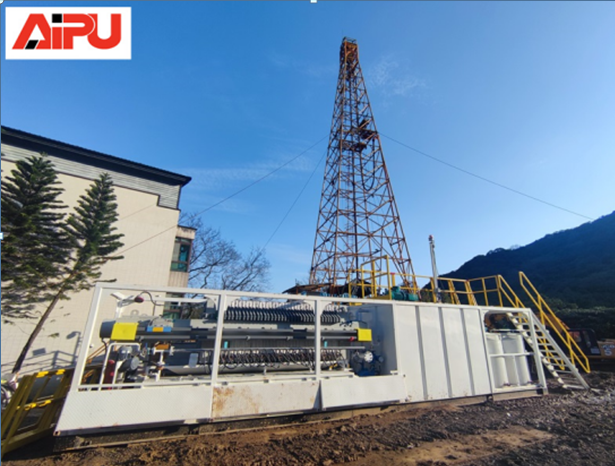Enhance Drilling Efficiency and More
Solids control equipment plays a crucial role in the drilling process. It helps to remove unwanted solids from the drilling fluid, ensuring the efficiency and safety of the drilling operation. This article will introduce several key types of solids control equipment.
Shale Shakers: The First Line of Defense
Shale shakers are the primary solids control equipment in a drilling system. They are designed to separate large cuttings from the drilling fluid. By using vibrating screens, shale shakers can effectively remove solids larger than the screen openings. The screens come in different mesh sizes, allowing operators to select the appropriate one based on the drilling conditions. The high - frequency vibration of the shaker ensures that the cuttings are quickly transported off the screen, preventing blockages and maintaining a continuous flow of drilling fluid. Shale shakers are essential for reducing the wear and tear on downstream equipment and improving the overall performance of the drilling fluid.
Hydrocyclones: Efficient Separation
Hydrocyclones are used for secondary solids control. They work on the principle of centrifugal force. When the drilling fluid enters the hydrocyclone at a high speed, the heavier solids are forced to the outer wall of the cyclone and are discharged through the bottom outlet, while the cleaner fluid exits from the top. There are different types of hydrocyclones, such as desanders and desilters. Desanders are used to remove larger particles, typically in the range of 40 - 100 microns, while desilters are designed for finer particles, usually between 15 - 40 microns. Hydrocyclones are highly efficient and can significantly improve the quality of the drilling fluid by removing a large amount of unwanted solids.
Decanter Centrifuges: Fine Separation
Decanter centrifuges are the most advanced solids control equipment. They are capable of separating very fine solids from the drilling fluid. The centrifuge uses a high - speed rotating bowl to generate a strong centrifugal force. The solids are forced to the outer wall of the bowl and are then conveyed out by a screw conveyor, while the clean fluid is discharged from the other end. Decanter centrifuges can handle a wide range of particle sizes, from a few microns to several millimeters. They are especially useful in situations where high - quality drilling fluid is required, such as in deep - well drilling or in environmentally sensitive areas.
Vacuum Degassers: Removing Gas
Vacuum degassers are used to remove entrained gas from the drilling fluid. Gas can enter the drilling fluid during the drilling process, which can cause problems such as reduced fluid density and increased risk of blowouts. Vacuum degassers work by creating a vacuum environment inside the tank. The drilling fluid is sprayed into the vacuum chamber, and the gas is released and removed. This helps to maintain the proper density and properties of the drilling fluid, ensuring the safety and efficiency of the drilling operation.
In conclusion, these solids control equipment pieces, including shale shakers, hydrocyclones, decanter centrifuges, and vacuum degassers, work together to provide a comprehensive solution for solids control in drilling. Their proper use and maintenance are essential for the success of any drilling project.

Shale Shakers: The First Line of Defense
Shale shakers are the primary solids control equipment in a drilling system. They are designed to separate large cuttings from the drilling fluid. By using vibrating screens, shale shakers can effectively remove solids larger than the screen openings. The screens come in different mesh sizes, allowing operators to select the appropriate one based on the drilling conditions. The high - frequency vibration of the shaker ensures that the cuttings are quickly transported off the screen, preventing blockages and maintaining a continuous flow of drilling fluid. Shale shakers are essential for reducing the wear and tear on downstream equipment and improving the overall performance of the drilling fluid.
Hydrocyclones: Efficient Separation
Hydrocyclones are used for secondary solids control. They work on the principle of centrifugal force. When the drilling fluid enters the hydrocyclone at a high speed, the heavier solids are forced to the outer wall of the cyclone and are discharged through the bottom outlet, while the cleaner fluid exits from the top. There are different types of hydrocyclones, such as desanders and desilters. Desanders are used to remove larger particles, typically in the range of 40 - 100 microns, while desilters are designed for finer particles, usually between 15 - 40 microns. Hydrocyclones are highly efficient and can significantly improve the quality of the drilling fluid by removing a large amount of unwanted solids.
Decanter Centrifuges: Fine Separation
Decanter centrifuges are the most advanced solids control equipment. They are capable of separating very fine solids from the drilling fluid. The centrifuge uses a high - speed rotating bowl to generate a strong centrifugal force. The solids are forced to the outer wall of the bowl and are then conveyed out by a screw conveyor, while the clean fluid is discharged from the other end. Decanter centrifuges can handle a wide range of particle sizes, from a few microns to several millimeters. They are especially useful in situations where high - quality drilling fluid is required, such as in deep - well drilling or in environmentally sensitive areas.
Vacuum Degassers: Removing Gas
Vacuum degassers are used to remove entrained gas from the drilling fluid. Gas can enter the drilling fluid during the drilling process, which can cause problems such as reduced fluid density and increased risk of blowouts. Vacuum degassers work by creating a vacuum environment inside the tank. The drilling fluid is sprayed into the vacuum chamber, and the gas is released and removed. This helps to maintain the proper density and properties of the drilling fluid, ensuring the safety and efficiency of the drilling operation.
In conclusion, these solids control equipment pieces, including shale shakers, hydrocyclones, decanter centrifuges, and vacuum degassers, work together to provide a comprehensive solution for solids control in drilling. Their proper use and maintenance are essential for the success of any drilling project.








